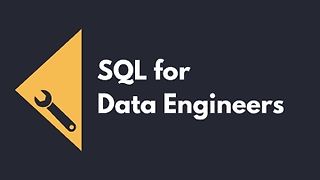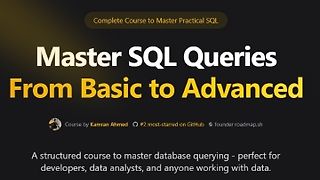SQL and PostgreSQL: The Complete Developer's Guide
Course description
SQL and PostgreSQL: The Complete developer’s Guide is a comprehensive SQL language training course and PostgreSQL database management system . Nowadays, all applications, from web applications and vmvyabel to a simple HTML page, need to store information in the database . Despite the numerous databases available, PostgreSQL has become the number one choice for developers due to its high efficiency, uninterrupted functionality and flexible design .
Read more about the course
During this period, even if you do not have any knowledge of the database, you will become its expert ! The course With provide an overview of the SQL language, that to interact with PostgreSQL is needed started, and then whatever for storage and get the data, the design of the structure, and tables for effective and optimized jQuery is necessary education is given .
In this course, you will be familiar with different types of data and how to deal with them and build a proportional database for each of them . Numerous examples and tests that are included throughout this course are very effective in understanding and learning its subjects . Among the topics this course can be used to learn the template design of the database, apply the commands of the powerful, SQL for the storage, update and get information. making connections between records, etc. familiarity with different type of data PostgreSQL and the application of them. receive reports from the trade data, etc. split the database into schema for access and maintenance easier, they and Data Validation using the rules noted . In addition to the aforementioned functional topics, you will also be familiar with how PostgreSQL works and how raw data is processed by it .
What things to learn
Learn and apply multiple database design patterns
Optimization of queries
Familiarity with the internal function of PostgreSQL
Connecting PostgreSQL to front-end applications using the API
Managing complex concurrency problems
Progress of database design using schema (schema )
And …
Watch Online
| # | Title | Duration |
|---|---|---|
| 1 | What is PostgreSQL All About? | 04:13 |
| 2 | Database Design | 05:12 |
| 3 | Creating Tables | 04:43 |
| 4 | Analyzing CREATE TABLE | 03:31 |
| 5 | Inserting Data Into a Table | 04:50 |
| 6 | Retrieving Data with Select | 02:08 |
| 7 | Calculated Columns | 04:38 |
| 8 | Calculating Phone Revenue | 00:59 |
| 9 | Exercise Solution | 01:04 |
| 10 | String Operators and Functions | 06:18 |
| 11 | Filtering Rows with "Where" | 03:50 |
| 12 | More on the "Where" Keyword | 02:31 |
| 13 | Compound "Where" Clauses | 05:25 |
| 14 | A "Where" Exercise Overview | 00:38 |
| 15 | A "Where" Solution | 00:57 |
| 16 | "Where" With Lists | 00:38 |
| 17 | A "Where" With Lists Solution | 01:43 |
| 18 | Calculations in "Where" Clauses | 02:06 |
| 19 | Solving Calculations | 01:52 |
| 20 | Updating Rows | 04:17 |
| 21 | Deleting Rows | 03:17 |
| 22 | A Solution for Updating Rows | 01:30 |
| 23 | Solution for Deleting Rows | 01:18 |
| 24 | The Plan Moving Forward | 01:44 |
| 25 | Approaching Database Design | 07:29 |
| 26 | One-to-Many and Many-to-One Relationships | 06:34 |
| 27 | One-to-One and Many-to-Many Relationships | 05:42 |
| 28 | Primary Keys and Foreign Keys | 05:30 |
| 29 | Understanding Foreign Keys | 08:20 |
| 30 | Auto-Generated ID's | 05:48 |
| 31 | Creating Foreign Key Columns | 04:39 |
| 32 | Running Queries on Associated Data | 06:49 |
| 33 | Exercise Overview | 02:08 |
| 34 | Foreign Key Creation Solution | 02:10 |
| 35 | Foreign Key Constraints Around Insertion | 05:36 |
| 36 | Constraints Around Deletion | 05:01 |
| 37 | Testing Deletion Constraints | 04:38 |
| 38 | Setting Foreign Keys to Null on Delete | 02:59 |
| 39 | Adding Some Complexity | 02:57 |
| 40 | Queries with Joins and Aggregations | 03:24 |
| 41 | Joining Data from Different Tables | 07:40 |
| 42 | Another Quick Join | 02:23 |
| 43 | Exercise Overview | 01:14 |
| 44 | A Joinful Solution | 01:44 |
| 45 | Alternate Forms of Syntax | 05:52 |
| 46 | Missing Data in Joins | 06:17 |
| 47 | Why Wasn't It Included | 02:23 |
| 48 | Four Kinds of Joins | 09:26 |
| 49 | Each Join in Practice | 04:15 |
| 50 | Does Order Matter? | 04:12 |
| 51 | Exercise Overview | 00:56 |
| 52 | Two Possible Solutions | 03:00 |
| 53 | Where with Join | 06:46 |
| 54 | Three Way Joins | 08:30 |
| 55 | A Bit of Practice | 04:59 |
| 56 | Exercise Solution | 02:53 |
| 57 | Aggregating and Grouping | 02:11 |
| 58 | Picturing Group By | 05:30 |
| 59 | Aggregate Functions | 03:00 |
| 60 | Combining Group By and Aggregates | 04:48 |
| 61 | A Gotcha with Count | 02:37 |
| 62 | Visualizing More Grouping | 03:11 |
| 63 | Exercise Overview | 00:40 |
| 64 | Grouping Solution | 01:22 |
| 65 | Adding a Layer of Difficulty | 00:43 |
| 66 | Solution | 01:28 |
| 67 | Filtering Groups with Having | 04:44 |
| 68 | Having In Action | 02:37 |
| 69 | More on Having! | 06:48 |
| 70 | A Having Exercise Overview | 03:37 |
| 71 | A Quick Solution | 02:33 |
| 72 | Investigating This Dataset | 02:35 |
| 73 | Some Group By Practice | 01:21 |
| 74 | Group By Review Solution | 02:26 |
| 75 | Remember Joins? | 02:14 |
| 76 | Of Course You Remember! | 01:26 |
| 77 | The Basics of Sorting | 02:15 |
| 78 | Two Variations on Sorting | 02:41 |
| 79 | Offset and Limit | 06:39 |
| 80 | Exercise Overview | 00:26 |
| 81 | Exercise Solution | 01:21 |
| 82 | Handling Sets with Union | 05:44 |
| 83 | A Few Notes on Union | 03:46 |
| 84 | Commonalities with Intersect | 03:24 |
| 85 | Removing Commonalities with Except | 05:50 |
| 86 | Union Exercise Overview | 01:27 |
| 87 | Exercise Solution | 01:28 |
| 88 | What's a Subquery? | 05:49 |
| 89 | Thinking About the Structure of Data | 04:47 |
| 90 | Subqueries in a Select | 05:42 |
| 91 | Exercise Overview | 01:06 |
| 92 | Select Solution | 01:19 |
| 93 | Subqueries in a From | 07:59 |
| 94 | From Subqueries that Return a Value | 02:46 |
| 95 | Example of a Subquery in a From | 08:57 |
| 96 | Exercise Overview | 01:16 |
| 97 | Exercise Solution | 02:00 |
| 98 | Subqueries in a Join Clause | 04:53 |
| 99 | More Useful - Subqueries with Where | 08:13 |
| 100 | Data Structure with Where Subqueries | 05:36 |
| 101 | Exercise Overview | 00:58 |
| 102 | Exercise Solution | 02:06 |
| 103 | The Not In Operator with a List | 04:10 |
| 104 | A New Where Operator | 06:21 |
| 105 | Finally Some! | 05:22 |
| 106 | Exercise Overview | 00:28 |
| 107 | A Quick Solution | 01:34 |
| 108 | Probably Too Much About Correlated Subqueries | 16:40 |
| 109 | More on Correlated Subqueries | 08:54 |
| 110 | A Select Without a From? | 03:29 |
| 111 | Exercise Overview | 00:46 |
| 112 | Exercise Solution | 01:20 |
| 113 | Selecting Distinct Values | 04:15 |
| 114 | Exercise Overview | 00:30 |
| 115 | A Distinct Solution | 00:41 |
| 116 | The Greatest Value in a List | 03:21 |
| 117 | And the Least Value in a List! | 02:02 |
| 118 | The Case Keyword | 04:14 |
| 119 | PostgreSQL Installation on macOS | 05:48 |
| 120 | pgAdmin Setup on macOS | 04:57 |
| 121 | Postgres installation on Windows | 03:56 |
| 122 | What'd We Just Do? | 04:03 |
| 123 | Data Types | 04:10 |
| 124 | Fast Rules on Numeric Data Types | 02:02 |
| 125 | More on Number Data Types | 09:20 |
| 126 | Reminder on Character Types | 04:43 |
| 127 | Boolean Data Types | 02:29 |
| 128 | Times, Dates, and Timestamps | 05:31 |
| 129 | Really Awesome Intervals | 05:45 |
| 130 | Thinking About Validation | 04:13 |
| 131 | Creating and Viewing Tables in PGAdmin | 07:20 |
| 132 | Applying a Null Constraint | 06:26 |
| 133 | Solving a Gotcha with Null Constraints | 04:10 |
| 134 | Default Column Values | 03:14 |
| 135 | Applying a Unique Constraint to One column | 05:36 |
| 136 | Multi-Column Uniqueness | 03:41 |
| 137 | Adding a Validation Check | 04:00 |
| 138 | Checks Over Multiple Columns | 05:05 |
| 139 | So Where Are We Applying Validation? | 05:47 |
| 140 | Approaching More Complicated Designs | 03:14 |
| 141 | Using a SQL Design Tool | 06:07 |
| 142 | A Config-based Schema Designer | 07:03 |
| 143 | Here's the Plan | 02:16 |
| 144 | Rebuilding Some Schema | 06:55 |
| 145 | Requirements of a Like System | 04:36 |
| 146 | How Not to Design a Like System | 02:59 |
| 147 | Designing a Like System | 05:05 |
| 148 | Making a Reaction System Instead | 01:36 |
| 149 | Polymorphic Associations | 05:59 |
| 150 | Polymorphic Association Alternative Implementation | 06:58 |
| 151 | The Simplest Alternative | 03:40 |
| 152 | So Which Approach? | 04:22 |
| 153 | Additional Features Around Posts | 06:11 |
| 154 | Adding Captions and Locations | 01:40 |
| 155 | Photo Mentions vs Caption Mentions | 07:28 |
| 156 | Considerations on Photo Tags vs Caption Tags | 07:09 |
| 157 | Update For Tags | 05:02 |
| 158 | Designing a Hashtag System | 07:34 |
| 159 | Tables for Hashtags | 03:37 |
| 160 | Including the Hashtag Table | 04:07 |
| 161 | A Few More User Columns | 06:02 |
| 162 | Why No Number of Followers or Posts? | 03:45 |
| 163 | Designing a Follower System | 05:51 |
| 164 | Back to Postgres | 01:46 |
| 165 | Creating Tables with Checks | 13:01 |
| 166 | Posts Creation | 08:33 |
| 167 | Comments Creation | 02:17 |
| 168 | Likes Creation | 06:53 |
| 169 | Photo Tags and Caption Tags | 05:29 |
| 170 | Creating Hashtags, Hashtag Posts, and Followers | 06:28 |
| 171 | Adding Some Data | 04:07 |
| 172 | Restoring from Scratch | 04:25 |
| 173 | Highest User ID's Exercise | 01:42 |
| 174 | Solution for User ID's | 01:10 |
| 175 | Posts by a Particular User | 01:06 |
| 176 | Solving for Posts by User | 01:57 |
| 177 | Likes Per User | 00:51 |
| 178 | Solution for Likes Per User | 01:42 |
| 179 | Thinking About Performance | 02:04 |
| 180 | Where Does Postgres Store Data? | 05:52 |
| 181 | Heaps, Blocks, and Tuples | 03:37 |
| 182 | Block Data Layout | 04:21 |
| 183 | Heap File Layout | 31:53 |
| 184 | Full Table Scans | 04:09 |
| 185 | What's an Index | 02:24 |
| 186 | How an Index Works | 07:59 |
| 187 | Creating an Index | 03:59 |
| 188 | Benchmarking Queries | 05:28 |
| 189 | Downsides of Indexes | 05:10 |
| 190 | Index Types | 01:36 |
| 191 | Automatically Generated Indexes | 03:38 |
| 192 | Behind the Scenes of Indexes | 31:56 |
| 193 | The Query Processing Pipeline | 04:58 |
| 194 | Explain and Explain Analyze | 05:26 |
| 195 | Solving an Explain Mystery | 09:00 |
| 196 | Developing an Intuitive Understanding of Cost | 11:58 |
| 197 | Calculating Cost by Hand | 06:22 |
| 198 | A Touch More on Costs | 07:18 |
| 199 | Startup vs Total Costs | 05:35 |
| 200 | Costs Flow Up | 01:49 |
| 201 | Use My Index! | 07:56 |
| 202 | Common Table Expressions | 01:53 |
| 203 | A Quick Solution | 03:53 |
| 204 | So What's a CTE? | 03:51 |
| 205 | Recursive CTE's | 03:19 |
| 206 | Recursive CTE's Step by Step | 10:22 |
| 207 | Why Use Recursive CTE's? | 04:34 |
| 208 | Writing the Query | 08:03 |
| 209 | Walking Through Recursion | 09:48 |
| 210 | Most Popular Users | 06:17 |
| 211 | A Possible Solution for Merging Tables | 03:52 |
| 212 | Creating a View | 05:37 |
| 213 | When to Use a View? | 03:20 |
| 214 | Deleting and Changing Views | 02:27 |
| 215 | Materialized Views | 02:19 |
| 216 | Grouping by Week | 04:09 |
| 217 | Reminder on Left Joins | 04:31 |
| 218 | Writing a Slow Query | 09:19 |
| 219 | Creating and Refreshing Materialized Views | 06:38 |
| 220 | What are Transactions Used For? | 04:04 |
| 221 | Some Sample Data | 02:00 |
| 222 | Opening and Closing Transactions | 09:45 |
| 223 | Transaction Cleanup on Crash | 04:04 |
| 224 | Closing Aborted Transactions | 01:46 |
| 225 | A Story on Migrations | 17:14 |
| 226 | Migration Files | 05:01 |
| 227 | Issues Solved by Migrations | 02:52 |
| 228 | A Few Notes on Migrations Libraries | 04:39 |
| 229 | Project Creation | 02:53 |
| 230 | Generating and Writing Migrations | 07:12 |
| 231 | Applying and Reverting Migrations | 07:16 |
| 232 | Generating and Applying a Second Migration | 03:39 |
| 233 | Schema vs Data Migrations | 04:09 |
| 234 | Dangers Around Data Migrations | 09:07 |
| 235 | Properly Running Data and Schema Migrations | 05:29 |
| 236 | Creating a Posts Table | 04:40 |
| 237 | A Small Web Server | 14:53 |
| 238 | Adding the Loc Column | 04:11 |
| 239 | Writing Values to Both Columns | 04:13 |
| 240 | Transaction Locks | 13:40 |
| 241 | Updating Values | 04:20 |
| 242 | Updating the App Server | 04:14 |
| 243 | Dropping the Last Columns | 03:02 |
| 244 | Section Goal | 00:53 |
| 245 | Initial Setup | 01:35 |
| 246 | One Fast Migration | 05:02 |
| 247 | Building the Users Router | 04:54 |
| 248 | Understanding Connection Pools | 06:32 |
| 249 | Validating Connection Credentials | 06:57 |
| 250 | Query and Close | 01:58 |
| 251 | The Repository Pattern | 03:39 |
| 252 | Creating a Repository | 08:21 |
| 253 | Accessing the API | 03:52 |
| 254 | Casing Issues | 04:22 |
| 255 | Fixing Casing | 06:34 |
| 256 | Finding Particular Users | 05:27 |
| 257 | SQL Injection Exploits | 06:41 |
| 258 | Handling SQL Injection with Prepared Statements | 07:49 |
| 259 | Preventing SQL Injection | 07:33 |
| 260 | Reminder on Post Requests | 02:52 |
| 261 | Inserting Users | 04:14 |
| 262 | Handling Updates | 04:37 |
| 263 | And, Finally, Delete | 04:06 |
| 264 | A Note on Testing | 02:48 |
| 265 | Assertions Around User Count | 07:05 |
| 266 | Connecting to a DB For Tests | 05:02 |
| 267 | Disconnecting After Tests | 02:46 |
| 268 | Multi-DB Setup | 04:41 |
| 269 | Assumptions Around Content | 04:45 |
| 270 | Issues with Parallel Tests | 04:49 |
| 271 | Isolation with Schemas | 04:10 |
| 272 | Creating and Accessing Schemas | 05:22 |
| 273 | Controlling Schema Access with Search Paths | 05:48 |
| 274 | Routing Schema Access | 04:03 |
| 275 | Strategy for Isolation | 04:44 |
| 276 | Programmatic Schema Creation | 11:45 |
| 277 | Escaping Identifiers | 04:21 |
| 278 | Test Helpers | 05:19 |
| 279 | Cleaning up Schemas and Roles | 05:57 |
| 280 | Finally... Parallel Tests! (Final Lecture) | 03:33 |
Similar courses

100 Days Of Code: The Complete Web Development Bootcamp 2024

SQL for Data Engineers

Learn Database Design with MySQL
